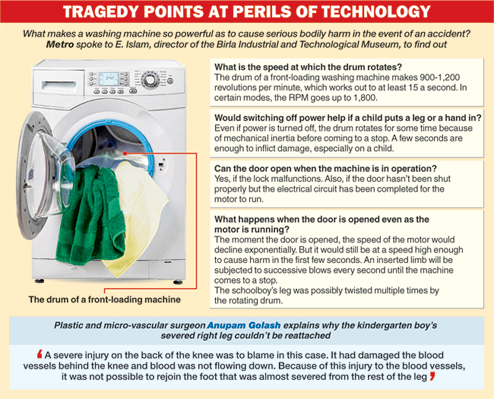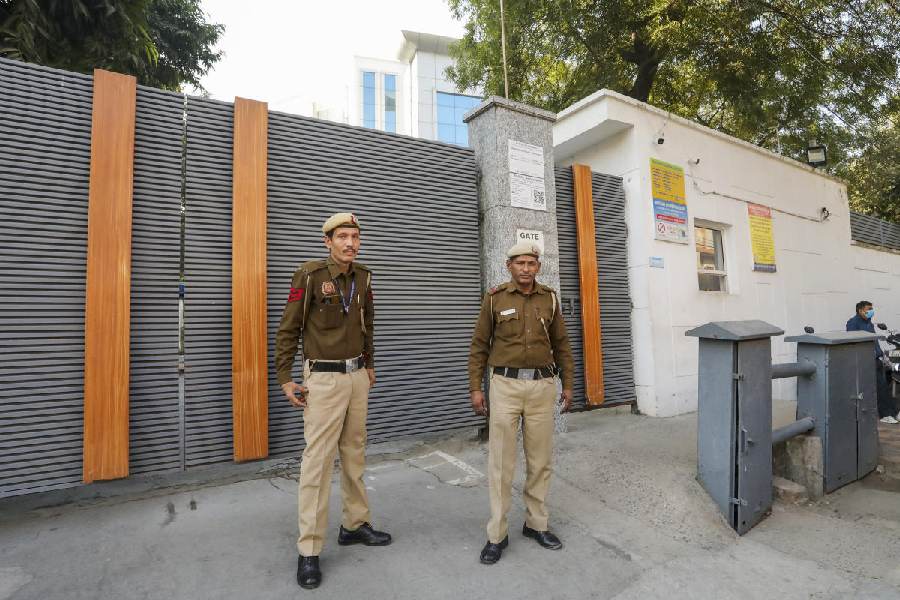A kindergarten student lost his right leg last week after he playfully put it inside a front-loading washing machine while it was in operation, the tragedy highlighting the hidden perils of technology in smart homes gleaming with gadgetry.
The five-year-old's father, a resident of Tollygunge in south Calcutta, said the lock of the front-loader had apparently malfunctioned, allowing his son to open it and put his foot in. The child's mangled right leg had to be amputated knee downwards.
"It was just for a few seconds but the blades must have been running because his foot got severed. We later understood that the door lock of the machine had malfunctioned. If it hadn't, my son wouldn't have been able to put his foot in," the father said.
The plastic surgeon who operated on the boy thrice recounted that his right foot "was hanging by small skin" when his family brought him to hospital. The right femur was fractured.
"We tried to reattach the foot on the first day but there was a lot of injury and it wasn't possible. The leg had to be amputated. In high-spin mode, a few seconds inside the washing machine is enough to cause such damage," plastic surgeon Anupam Golash said.
Seeing the smile back on the boy's face as he recuperates in hospital from the ravages of the terrible accident, it is hard to imagine the pain he would have suffered. And for parents who would wince at the thought, there are some difficult questions to answer about whether to put small children on a leash or let them learn from the fall.
Doctors and experts in child behaviour still advocate giving kids the "space" they need to grow and learn, though the tragedy in a Tollygunge home has introduced an element of fear into freedom.
Almost all urban homes have microwaves, mixer-grinders, hand blenders, toasters, irons and washing machines that can be potentially dangerous for kids, both in the presence and absence of parents. But it's also natural for children in the exploratory stage to want to touch and feel and find out what an object is.
So how do parents strike the balance between letting kids explore and also keep them from harm?
"There are many household items that can be hazardous for children, more so if they malfunction. The most common instances we know of are of children putting their hands through collapsible gates in lifts," Golash said.
A mixer-grinder can be just as hazardous, as the mother of a three-year-old learnt recently. "I had switched on the mixer but the jar was not on it and the blades started running. My daughter was on the verge of putting a hand on the mixer when I stopped her. I immediately turned it off," the mother recalled.
A lawyer with a daughter who is a month short of three years said he and his wife were constantly worried about their child's habit of sticking her fingers into the holes of electrical sockets. "Most of the plug points like the one for our microwave oven are beyond her reach but the television point is accessible and so we have to keep any eye on her."
Orthopaedic surgeon Goutam Saha said parents should also be careful about ladders. "Ladders should be out of reach of children. If they use one to reach a fan or a loft, that would be dangerous."
Debjani Rudra, head of the junior section at La Martiniere for Girls, said children couldn't be faulted for being curious. "There comes a time when children discard toys for keys, mobile phones, medicine bottles and empty cans. It is an explorative stage and such natural curiosity is part of the development and growth of the child."
According to Rudra, it should be acceptable for a parent till a child is playing with a key but not swallowing it. "In any case, it is very difficult for parents to monitor everything unless there is a child-lock system in every gadget."
Educators say the challenge of parenting is knowing when and where to say no.
"It's not enough to ask children not to play with a matchbox or a knife. Children need to be made to understand in a rational manner rather than scaring them about the outcome. If a child is told not to use matchsticks because he will burn the house down, he won't understand. What he needs to be told is that he could end up burning his clothes and scalding himself, which would be painful," Sunirmal Chakravarthi, principal of La Martiniere for Boys, said.
At the same time, parents can neither teach children everything they need to know nor anticipate what they might end up doing. "A parent can let the child put his or hand in a glass of hot milk to understand the heat but not in water boiling over a gas stove to show how high temperature can scald," a kindergarten teacher said.
Psychiatrist J.R. Ram said the sensible thing to do was to warn rather than curb. "A child needs to be warned constantly. He or she can be shown what happens to an apple that is put in the mixer and told that the same can happen if someone puts a hand inside."
But what about children who are prone to trying out anything they have been asked not to do?
"It's important to know the child and, perhaps, pre-empt some actions. If I know my child reasonably well and that he or she is impulsive or oppositional in nature, I would try to keep things out of reach like the electrical sockets," psychiatrist Ram said.
But accidents do happen and on many occasions it isn't anyone's fault. "The Tollygunge boy was the victim of a freak accident. Though such instances make parents review house rules, you cannot always prevent accidents that don't occur out of carelessness," said Devi Kar, director of Modern High School for Girls.
Sharmila Bose, principal of Sushila Birla Girls' School, too warned against pressing the panic button. "This is an extreme case but broken bones, stitches on the forehead and wounds are part of growing up," she said.
How would you protect your child without curbing his/her freedom to fall and learn? Tell ttmetro@abpmail.com











